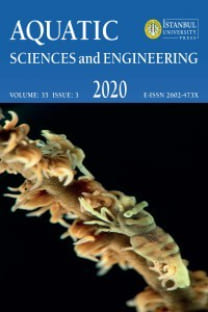Determination of the Risky Microorganisms in Frozen Ready-to-Eat Seafood Sold in Istanbul Market
Determination of the Risky Microorganisms in Frozen Ready-to-Eat Seafood Sold in Istanbul Market
Since frozen ready-to-eat seafood has the potential to cause food poisoning, this study focuses on microorganisms that have the potential to be a health hazard found in frozen ready-to-eat seafood, which is sold to highly populous communities. Therefore, the most popular frozen ready-to-eat seafood, fish balls and surimi crab legs, from Istanbul market were studied. Samples were gathered from seven different branches of four major chain market brands, twice in winter (October-March) and twice in summer (April-September). As a result of seasonal conditions summer samples had higher microbial loads compared to winter samples. The average mesophilic and psychrophilic aerobic bacteria counts of fish balls and surimi crab legs were below ≤4 log cfu/g. All samples were safe in terms of Salmonella, Vibrio parahaemolyticus and Vibrio cholerae; and acceptable in terms of Staphylococcus aureus Clostridium perfringens, and Bacillus cereus. The microbiological load of fish balls was higher (p<0.05) than the other samples. It was observed that more than 80% of them are risky in terms of coliform bacteria. It is concluded that attention should be paid especially to minced and spice added products. It is essential to pay more attention to the marketing of ready-to-eat seafood during the summer seasons for the prevention of public health.
Keywords:
Pathogen, seafood, surimi crab leg, fish balls ready to eat, frozen,
___
- Alvarez-Astoga, M., Capita, R., Alonso-Calleja, C., Moreno. B., Garcia-Fernandez, M. C. (2002). Microbiological quality of retail chicken by-products in Spain. Meat Science, 62: 45-50.
- Andrews, W. H., Jacobson, A., Hammack, T., 2011. Microbiological Analytical Manual (BAM), www.fda.gov/food/laboratory-methods-food/bam-chapter-5-salmonella. Anon, 2011. Resmi Gazete, Türk Gıda Kodeksi Mikrobiyolojik Kriterler Yönetmeliği, Sayı: 28157, 3. Mükerrer.
- Baumgart, J., 1986, Lebensmittel tierischer Herkunft, Feinkosterzeugnisse, gefrorene, tiefgefrorene und getrocknete lebensmittel, Fertiggerichte, hitzekonservierte Lebensmittel, Speiseeis, Zucker, Kakao, Zuckerwaren, Rohmassen. Mikrobiologische Untersuchung von Lebensmitteln, Edt: Jürgen Baumgart, unter Mitarbeit von Jürgen Firnhaber, Gottfried Spicher, 207, Behr’s Verlag, Hamburg, 3-922528-91-0.
- Christison, C. A., Lindsay, D. & Holy, A. (2008) Microbiological survey of ready-to-eat foods and associated preparation surfaces in retail delicatessens, Johannesburg, South Africa. Food Control, 19: 727-733
- Feng, P., Weagant, S., Grant, M., Burkhardt, W. 2020, Bacteriological Analytical Manual (BAM), Chapter 4. https://www.fda.gov/food/laboratory-methods-food/bam-chapter-4-enumeration-escherichia-coli-and-coliform-bacteria (accessed 13.04.2021)
- Forsythe, S. J; The Microbiology of Safe Food Second Edition Wiley-Blackwell ISBN 978-1-4051-4005-8, 286-287 Ganowiak, Z. M., 1990, Sanitation in marine food industry, Edt.: SIKORSKI, Z.E. Seafood: resources, nutritional composition, and prevention, CRC Press Inc., Boca Raton, Florida
- Giannakourou, M. C. & Taoukıs, P. S. (2005). Monitoring and control of the cold chain. In Sun, D.W. (Ed.), Handbook of frozen food processing and packaging 1 edition, Boca Raton, CRC Press, 157444607X.
- Gonzalez, R. D., Tamagnini, L. M., Olmos, P. D. & De Sousa, G. B. (2003). Evaluation of a chromogenic medium for total coliforms and Escherichia coli determination in ready-to-eat foods. Food Microbiology, 20: 601-604.
- Halkman, K., 2005, Mikroorganizma Analizi, Gıda Mikrobiyolojisi Uygulamaları, Ankara, ISBN: 975-00373-0-8.
- ICMSF, (1986), International Commission on Microbiological Specifications for Foods, Sampling Plans for Fish and Shellfish. In: Elliott RP, Clark DS, Lewis KH, Lundenbeck H, Olsen JC and Simonjen JB (Eds.) Microorganisms in foods. Sampling for Microbiological Analysis: Principles and Scientific Applications, Canada, ICMSF Toronto Press, University of Toronto, pp 181-196.
- ICMSF , 1988, Application of the Hazard Analysis Critical Control Point (HACCP) System to Ensure Microbiological Safety and Quality, Blackwell Scientific Publications, Oxford London, ISBN: 0-632-02181-0.
- Iurlina, M. O., Saiz, A. I., Fuselli, S. R. & Fritz, R. (2006). Prevalence of Bacillus spp. in different food products collected in Argentina. LWT-Food Science and Technology, 39: 105-110
- Juneja, V, K.; Novak, J.S.; Labbe, R. J., 2009 Chapter 4 Clostridium perfringens (Pages: 53-70). Pathogens and Toxins in Foods: Challenges and Interventions Editor(s): Vijay K., JunejaJohn N. Sofos ISBN:9781119737926
- Kala, E. (2006). Dondurulmuş gıdalarda (et ve sebze) fekal koliform ve fekal streptokokların varlığı. Yüksek Lisans, Gazi Üniversitesi Fen Bilimleri Enstitüsü. Karaboz, İ. & Dinçer, B. (2002). Microbiological investigation on some food the commercial frozen meat in İzmir, Turkish Electronic Journal of Biotechnology, Special Issue 21: 18-23.
- Kaysner, C. A., DePaola, Jr. A., Jones, J., (2004) Bacteriological Analytical Manual (BAM). www.fda.gov/food/laboratory-methods-food/bam-chapter-9-vibrio. Little, C. L., Omotoye, R. & Mitchell, R. T. (2003). The microbiological quality of ready-to-eat foods with added spices. International Journal of Environmental Health Research, 13: 31-42.
- Mol, S. & Varlık, C. (2004). Hazır Yemek Teknolojisi (Catering), In:Varlik, C. (Ed.), Su Ürünleri İşleme Teknolojisi. İstanbul, İstanbul Üniversitesi Yayını. 975-404-715-4.
- Mol, S., Erkan, N., Üçok, D. & Tosun, Ş.Y. (2007). Effect of psychrophilic bacteria to estimate fish quality. Journal of Muscle Foods, 18: 120-128.
- Oranusi, S., Obioha T.U.; Adekeye, B.T. International Journal of Advanced Research in Biological Sciences 2014; 1(2): 71-78
- Rhodehamel, J. and Harmon, S., 2001a, Bacteriological Analytical Manual, 8th Edition, 1998. Chapter 14.
- Rhodehamel, J. and Harmon, S., 2001b, Bacteriological Analytical Manual, 8th Edition, 1998. Chapter16.
- Suvanish, V., Marshall, D. L. & Jahncke, M. I. (2000). Microbiological and color quality changes of channel catfish frame mince during chilled and frozen storage. Journal of Food Science, 65 (1), 151-154.
- Tallent, S., Hait, J., Bennett, R. W., Lancette, G. A. (2016). Bacteriological Analytical Manual (BAM), www.fda.gov/food/laboratory-methods-food/bam-chapter-12-staphylococcus-aureus.
- Umoafia G. E. & Okoro C. U., 2018 Effects of Freezing and Thawing on the Microbiological and Physicochemical Qualities of Frozen Pork. World Journal of Pharmaceutical and Medical Research, 4(2), 169-173.
- Umoh, V.J. & Odoba, M. B. (1999). Safety and quality evaluation of street foods sold in Zaria Nigeria. Food Control, 10: 9-14.
- Vural. A. & Yeşilmen, S. (2003). Diyarbakır’da satışa sunulan çiğ köftelerin mikrobiyolojik kalitesi üzerine bir araştırma. Türk Mikrobiyoloji Cemiyeti Dergisi, 33: 350-355.
- Yalçın, H. 2020. Investigation of microbiological quality of surimi sold in the market. Veterinary Journal of Mehmet Akif Ersoy University 5(1):18-22.
- Yayın Aralığı: Yılda 4 Sayı
- Başlangıç: 1987
- Yayıncı: İstanbul Üniversitesi
